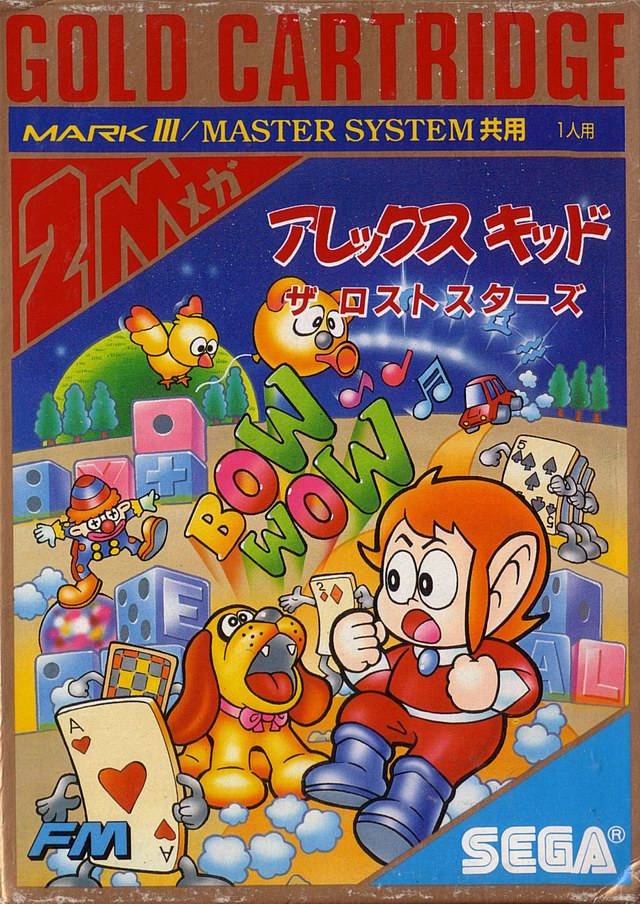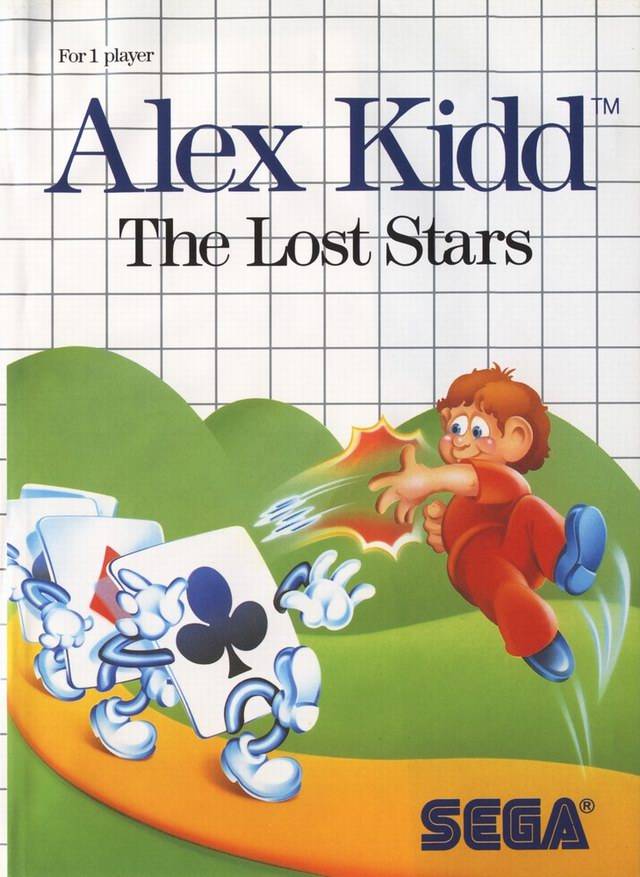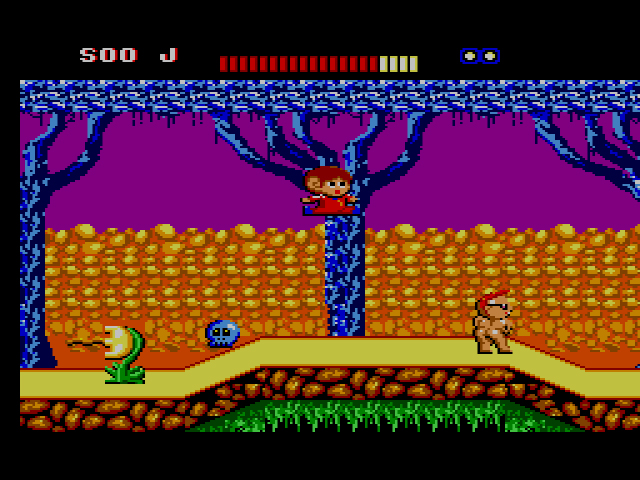

PLAYERS: 1
PUBLISHER/DEVELOPER: Sega
GENRE: Platformer
RELEASE DATE: 03/10/88 – (JP), 07/88 – (US), 1988 – (EU)
Alex Kidd: The Lost Stars might be the direct sequel to Alex Kidd in Miracle World, but it doesn’t play like the latter’s descendant. Miracle World is calm, methodical, and solves most of its battles with rock-paper-scissor matches. Lost Stars is impetuous, freewheeling, and will destroy anything in its path if it has to. This probably has to do with Lost Stars originally being an arcade game before being ported to the Master System. Whatever emphasis was put on careful exploration in Miracle World has been excised in favor of getting to the end of the level as quickly as possible. And that’s ok. If Super Mario Bros. 2 (USA) and Zelda II taught us nothing else, it’s that developers have a right to do whatever they want with sequels, players’ expectations be damned.
![Alex Kidd - The Lost Stars (UE) [!]000](https://segadoes.com/wp-content/uploads/2015/05/alex-kidd-the-lost-stars-ue-000.jpg?w=300)
The story: after saving Aries, the Miracle World, Alex learns that the twelve stars in the Aries constellation have been stolen by Ziggarat, an evil being of great power (probably – the manual is quite vague as to who or what Ziggarat is). Your goal is to rescue the twelve miracle balls, release the stars back into the sky, and defeat Ziggarat forever.
![Alex Kidd - The Lost Stars (UE) [!]007](https://segadoes.com/wp-content/uploads/2015/05/alex-kidd-the-lost-stars-ue-007.jpg?w=300)
To find the miracle balls, you’ll have to go through each of the game’s seven worlds twice. This might seem like needless repetition, but thankfully, the levels are colorful, entertaining, and a bit bonkers. There’s the Toy Realm, where vengeful toys hunger for Alex’s royal blood (he’s a prince, lest we forget), a Machine World populated by robots and ducks, the World of Make Believe where you won’t believe that there’s a naked mohawked enemy shooting skulls out of his butt, a Water World with enemies that are Totally Not Bloopers, a Monster World where you zip line into a dinosaur’s mouth, a Giant’s Body ruled by rolling doll heads and green gas clouds, and finally, the Shrine of Ziggurat, which takes place in the shriveled nethers of space.
![Alex Kidd - The Lost Stars (UE) [!]004](https://segadoes.com/wp-content/uploads/2015/05/alex-kidd-the-lost-stars-ue-004.jpg?w=300)
Precise jumps are vital to beating the game, particularly since Alex always starts each level without a weapon (his fist must be too bruised from all the punching and rock-paper-scissoring he did in Miracle World). The slippery controls from Miracle World have been refined to perfection. Alex jumps almost as well as his hero, Mario, with any error in jumps resulting from poor timing on your part, not the game’s. Later during the level, Alex gains Shots to fire from ‘S’ power-ups that descend from the sky. The shots have a limited number, though, and they only take out the smaller enemies; anything larger than the Shot itself won’t be scathed. Thus, proper jumping is still the most crucial aspect to Alex’s survival.
![Alex Kidd - The Lost Stars (UE) [!]005](https://segadoes.com/wp-content/uploads/2015/05/alex-kidd-the-lost-stars-ue-005.jpg?w=300)
Alex’s life meter/time limit – ripped straight from Sega/Westone’s Wonder Boy – requires constant progression. The meter reduces little by little as you go through the stage, and if you get hit once by any enemy, two bars are taken away. Throughout each level, ‘SC’ (stands for ‘seconds’) power-ups will replenish bits of your meter, but as with all of the power-ups, they descend from the sky at random intervals. If you run out of life/time, you’ll die and start from the beginning of the stage.
![Alex Kidd - The Lost Stars (UE) [!]006](https://segadoes.com/wp-content/uploads/2015/05/alex-kidd-the-lost-stars-ue-006.jpg?w=300)
Unless you’re new to platformers, death won’t happen very often. Alex Kidd: The Lost Stars is a surprisingly easy game. ‘Surprising,’ because Sega typically doesn’t make easy games, either on the Master System or the arcade. Lost Stars isn’t without challenge, per say – thanks to Alex’s generous frame, running into enemies is guaranteed a handful of times in most levels – but it cancels out any difficulty with abundant power-ups and unlimited continues. Even in the harder second playthrough, the game provides you with just enough Shots and extra health to get you through.
![Alex Kidd - The Lost Stars (UE) [!]009](https://segadoes.com/wp-content/uploads/2015/05/alex-kidd-the-lost-stars-ue-009.jpg?w=300)
The Lost Stars has Japanese weirdness coursing through its veins, more so than any of the Kidd’s previous outings. Every time Alex dies, he shrieks like he’s being run through a wood chipper. The more you hear him scream, though, the funnier it becomes. Perhaps I’m just sick, but I think that was Sega’s intent. “I jumped into a spike bed/Just to hear Alex cry” to paraphrase Johnny Cash. Enemies range from little toy cars to the aforementioned naked skull-blasting punk to open-mouthed dogs that attack you with letters that spell “BOWWOW.” After you beat the game and free the stars from the miracle balls, the Statue of Liberty appears in space, as if to congratulate you on a job well done. Then there’s Ziggarat (misspelled at times in the manual as ‘Jiggarat’…), a ball of flame that shoots out smaller balls at you. You can’t kill him (or any boss for that matter), but you can kill his flaming ball children and walk right past him to the end.
![Alex Kidd - The Lost Stars (UE) [!]010](https://segadoes.com/wp-content/uploads/2015/05/alex-kidd-the-lost-stars-ue-010.jpg?w=300)
I acknowledge that Miracle World is the better of the two proper Alex Kidd adventures I’ve explored thus far. The game was like nothing else in its day. With the different vehicles, collectible power-ups, and RPS battles, Miracle World was a singular creation, a platformer that felt like a true adventure and not just mere running from left to right. And yet, Miracle World also plays like Sega taking tentative steps into a genre it’s not fully comfortable with. Alex Kidd controls like he is cautious and unsure of himself, even though the game he finds himself in remains meticulously crafted. Lost Stars by contrast is a pure arcade platformer built on the backs of pure arcade platformers that came before – Wonder Boy, Super Mario Bros, etc. The game doesn’t care about breaking ground, it just wants to be fast and fun and oh-so-strange. So it is, and that’s enough for me.
B+


7 replies on “Alex Kidd: The Lost Stars (Master System, 1988)”
I always like to to think of this as the Gaiden entry In the series. The enchanted castle on the Genesis is more of a direct sequel to Miracle World. This is a proper Alex Kidd game but is more of a one off that doesn’t play like the other two. It is like you said an arcade type of game. To me it always felt like a more direct challenge to Mario. While the gameplay and level design are much simplified in comparison, it certainly makes up for that with originality. I give it credit for unique enemies in each world, and wildly different worlds that are also all unique. Definetly worth checking out.
When you first posted about this on Twitter, I really wanted to find a sound clip of Alex Kidd’s death scream and add it as a reply. But alas, none could be found. I think the voice in the game is one of the things that made the game memorable for me. As grainy as it was.
Overall I think I was somewhat disappointed in the simplified direction this game took. And story wise it didn’t really have anything to do with the other two main games. Still one of the better platformers on the system.
Alex Kidd’s death scream really annoyed me at first, but I actually enjoyed it the more I heard it.
I remember playing this game all the time. I think the reason I liked it so much was because it was very easy and I could beat it with out pulling my hair out like the original Alex Kidd did on the last few levels.
Also another reason I liked this game was no Jan-ken to deal with!!!!
I play the arcade version on MAME every so often and I think the SMS version is a good conversion of the arcade game.
I do think the original Alex Kidd game is an overall deeper game but I still have great memory’s with this game.
Great review like always. Bow Wow
It’s cool that the arcade had two-player co-op with Alex’s creepy female twin, Stella. I’m not surprised she didn’t make it to the home version, though.
At least he’s not riding a BMX while trying to get to an arcade – see what I did there? Put two Alex Kidd game references in one sentence. I amuse myself quite easily. Anyway, quite a thorough review there and I liked the way you distinguished the two games. I have to put this on my list of games to get.
All I remember is staying up until 1:00 a.m., trying to beat this game, seeing the final screen, and then just the words “THE END”. I slammed the power switch in disgust and went to bed.
Endings for old games are almost always terrible.